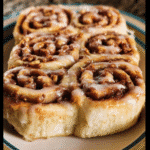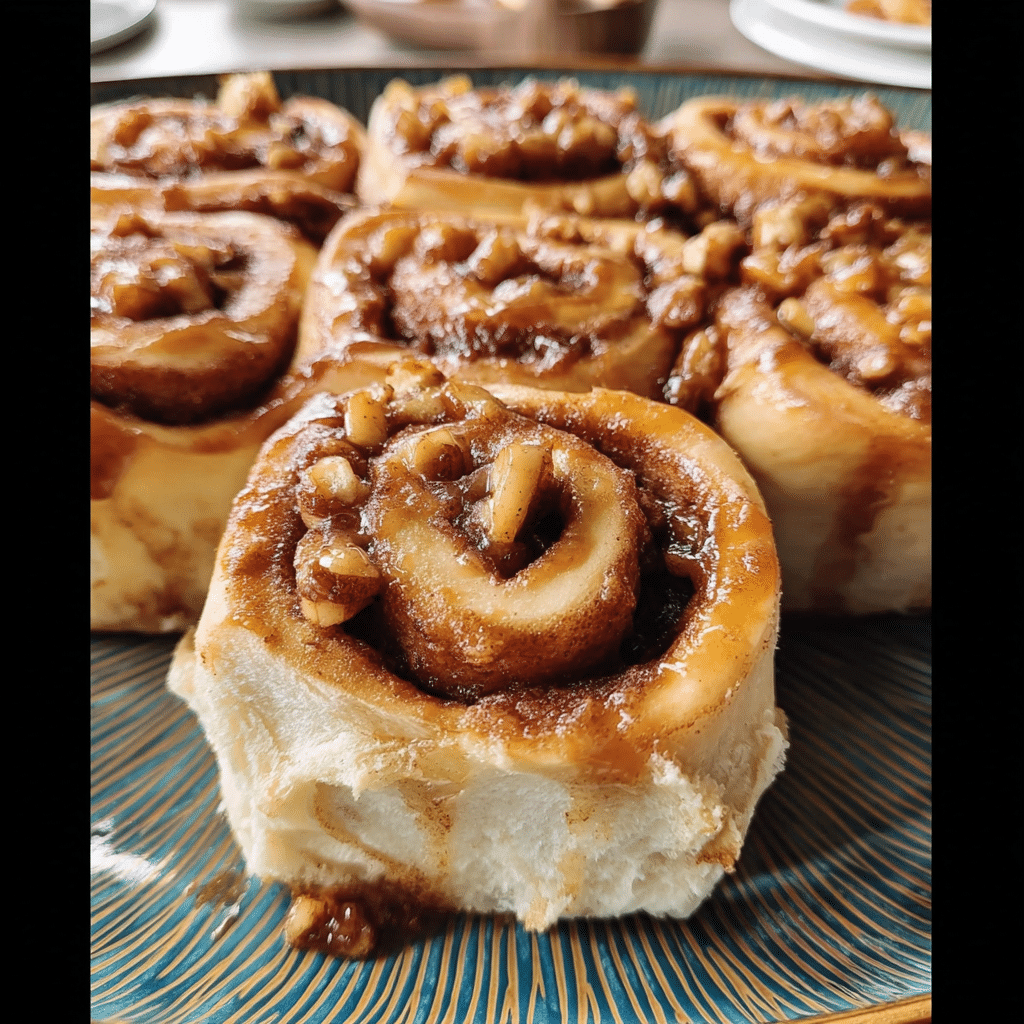Apple cinnamon roll—these three words evoke a warm, nostalgic feeling that transports me back to my grandmother’s cozy kitchen, where the tantalizing aroma of freshly baked rolls filled the air. I remember the first time I encountered this delightful treat; I was a child visiting my grandmother during autumn. She would invite me into her kitchen, where the sunlight streamed through the window, illuminating the flour-dusted countertops. We would spend the afternoon together, mixing, kneading, and rolling dough, while the sweet smell of cinnamon and apples danced around us. It was in those moments that I fell in love with the idea of creating something magical from simple ingredients.

The apple cinnamon roll is not just a dessert; it’s a cherished memory, a symbol of comfort, and a family tradition that has been passed down through generations. The combination of warm, gooey cinnamon-spiced apples nestled within soft, pillowy dough is simply unbeatable. This recipe stands out from others because it brings together the sweetness of apples, the warmth of cinnamon, and the soft, buttery texture that makes each bite a comforting experience. In today’s fast-paced world, where busy families often struggle to find time for meals, this apple cinnamon roll recipe offers a delightful solution. It can serve as a quick breakfast option, a fun snack for the kids after school, or even as a dessert to cap off a family dinner.
The Story Behind This Recipe
As I grew older, my love for baking led me to explore different recipes, but none captivated my heart quite like the apple cinnamon roll. I began experimenting with various ingredients, adding my own twist to the classic recipe. Sometimes I would toss in a handful of pecans for added crunch or drizzle a cream cheese frosting on top for a decadent finish. Each variation brought its own charm, but the essence of the apple cinnamon roll remained the same—comfort and warmth.
Seasonal relevance is another reason why this recipe holds a special place in my heart. Autumn, with its crisp air and falling leaves, is when apples are at their peak, making it the perfect time to whip up a batch of these rolls. There’s something about the combination of apple and cinnamon that screams fall, making it a wonderful treat for family gatherings or cozy nights in. The emotional connection I have with this dish runs deep; it symbolizes family, love, and the simple joys of life. Whenever I pull a tray of freshly baked apple cinnamon rolls from the oven, I can’t help but smile, knowing that I’m creating new memories for my own family.
In this guide, you will learn everything you need to know about making the perfect apple cinnamon roll. From the ingredients you’ll need to tips for achieving that fluffy texture, I promise you’ll find this recipe both accessible and rewarding. Whether you’re a seasoned baker or just starting in the kitchen, this apple cinnamon roll recipe will become a staple in your home. So tie on your apron, and let’s get started on creating a treat that’s sure to bring joy to your family just as it has to mine!
The Rich History and Cultural Significance of apple cinnamon roll
The rich history and cultural significance of the apple cinnamon roll traces back to the heart of culinary traditions in many cultures. While the exact origins of the apple cinnamon roll can be somewhat elusive, it is widely believed that its roots lie in the classic cinnamon roll, which has been enjoyed in various forms across Europe for centuries. The idea of combining apples with cinnamon in baked goods likely emerged as a result of the abundance of apples in many regions and the desire to create something comforting and delicious.
Origins and History
Cinnamon rolls themselves can be traced back to ancient times, with evidence of sweetened bread being enjoyed in places like Ancient Egypt. However, it was in Northern Europe, particularly in Sweden, that the modern cinnamon roll began to take shape. Known as “kanelbullar,” these treats are often enjoyed during coffee breaks and special occasions. The addition of apples to this delightful mix likely began as a practical way to utilize seasonal produce, giving rise to the apple cinnamon roll that we know and love today.
As the apple cinnamon roll made its way to America, particularly during the 19th century, it became a beloved dessert among families. It was often prepared for special occasions and gatherings, symbolizing warmth and togetherness. The American version of this treat has evolved, incorporating local ingredients and flavors, resulting in variations that reflect regional tastes. From the classic version topped with a simple glaze to more elaborate versions drizzled with cream cheese frosting, the apple cinnamon roll has become a versatile dish celebrated across the country.
Cultural Significance
The apple cinnamon roll holds a special place in various cultural traditions. In the United States, it’s common to find these rolls served at holiday gatherings, brunches, and family celebrations. They are often associated with autumn, particularly around Thanksgiving, when apples are in season, and families gather to share meals. The comforting flavors of cinnamon and apples evoke nostalgia, reminding many of family gatherings and cherished moments spent around the table.
Across the globe, variations of the apple cinnamon roll can be found in different cultures. For instance, in Germany, a similar pastry known as “apfelstrudel” features apples and cinnamon wrapped in flaky pastry. In France, the “tarte Tatin” showcases caramelized apples with a buttery crust. These dishes highlight the universal appeal of combining apples and cinnamon, showcasing how the flavors resonate with different cultures while still maintaining a sense of familiarity.
Nutritional Benefits
Beyond its comforting taste, the apple cinnamon roll also offers some nutritional benefits. Apples are a great source of dietary fiber, vitamin C, and various antioxidants. Incorporating apples into your baking not only adds flavor but also boosts the nutritional value of the dish. Cinnamon, too, is known for its health benefits, including anti-inflammatory properties and the potential to help regulate blood sugar levels. By choosing quality ingredients and moderating the sugar content, you can enjoy this delicious treat while still being mindful of your health.
As we delve deeper into the world of apple cinnamon rolls, you will discover not only the joy of baking but also the cultural significance and history that make this dish so special. Each roll you create is a celebration of flavors, traditions, and memories. So, let’s embrace the joy of baking and explore the rich heritage behind the beloved apple cinnamon roll!
Essential Ingredients for Perfect apple cinnamon roll
When it comes to baking the perfect apple cinnamon roll, the foundation lies in the choice of ingredients. Each element plays a crucial role in delivering that comforting, warm, and indulgent experience we all crave. Let’s dive deep into the essential ingredients for creating your very own apple cinnamon rolls, exploring their roles, quality indicators, and tips for sourcing them.
Essential Ingredients
- All-purpose flour: 4 cups (plus extra for dusting)
- Granulated sugar: 1/2 cup
- Brown sugar: 1/2 cup (packed)
- Salt: 1 teaspoon
- Active dry yeast: 2 1/4 teaspoons (1 packet)
- Milk: 1 cup (whole or 2%, warmed)
- Butter: 1/2 cup (unsalted, melted)
- Eggs: 2 large (room temperature)
- Ground cinnamon: 2 tablespoons
- Apples: 2 medium (peeled, cored, and chopped; Granny Smith or Honeycrisp work well)
- Vanilla extract: 1 teaspoon
- Icing sugar: 1 cup (for glaze)
- Heavy cream: 1/4 cup (optional, for a richer roll)
Each ingredient in this list plays a vital role in the final product. The all-purpose flour provides the structure, while the combination of granulated sugar and brown sugar offers a sweet balance; brown sugar gives that delightful caramel undertone that pairs so beautifully with apples. Salt enhances the flavors, and active dry yeast is essential for that fluffy rise.
Using warm milk activates the yeast, ensuring a good rise, while unsalted butter adds richness and moisture. The eggs contribute to the dough’s texture, resulting in a soft and pillowy roll. The ground cinnamon is the star of the show, providing that warm, inviting aroma synonymous with apple cinnamon rolls. Finally, the apples add a burst of flavor and moisture, keeping the rolls deliciously tender.
Print
Apple Cinnamon Roll
Ingredients
- 1 cup (240ml) whole milk, warmed to about 100°F (38°C)
- 2/3 cup (135g) granulated sugar, divided
- 1 and 1/2 Tablespoons (14g) Platinum Yeast from Red Star (2 standard–size packets)*
- 1/2 cup (113g) unsalted butter, softened to room temperature and cut into 4 pieces
- 2 large eggs, at room temperature
- 1/2 teaspoon salt
- 4 and 1/2 cups (563g) all-purpose flour or bread flour (spoon & leveled), plus more as needed
Filling
- 6 Tablespoons (85g) unsalted butter, softened to room temperature
- 1/2 cup (100g) packed light or dark brown sugar
- 1 and 1/2 Tablespoons ground cinnamon
- 2 cups (250g) peeled chopped apples (about 2 medium apples)
Icing
- 1 cup (120g) confectioners’ sugar
- 1/2 teaspoon pure vanilla extract
- 2 Tablespoons milk
- 2 Tablespoons warmed salted caramel
Instructions
- Prepare the dough: Whisk the warm milk, 2 Tablespoons sugar, and the yeast together in the bowl of your stand mixer fitted with a dough hook or paddle attachment. Cover and allow mixture to sit for about 5 minutes or until foamy on top. *If you do not own a mixer, you can do this in a large mixing bowl and in the next step, mix the dough together with a large wooden spoon/silicone spatula. It will take a bit of arm muscle. A hand mixer works, but the sticky dough repeatedly gets stuck in the beaters. Mixing by hand with a wooden spoon or silicone spatula is a better choice.*
- On medium speed, beat in the remaining sugar (which should be 1/2 cup/100g) and the softened butter until it is slightly broken up. Add the eggs and salt and beat on medium speed until combined. The butter won’t really be mixing into the mixture, so don’t be alarmed if it stays in pieces. Switch the mixer down to low speed and with it running, add 1 cup of flour at a time, making sure it’s fully incorporated before adding the next. After 4 cups have been added, add the last 1/2 cup and beat until the dough comes together and pulls away from the sides of the bowl, about 3 minutes. Dough will be soft.
- Knead the dough: Keep the dough in the mixer and beat for an additional 5 full minutes, or knead by hand on a lightly floured surface for 5 full minutes. If the dough becomes too sticky during the kneading process, sprinkle 1 teaspoon of flour at a time on the dough or on the work surface/in the bowl to make a soft, slightly tacky dough. Do not add more flour than you need because you do not want a dry dough. After kneading, the dough should still feel a little soft. Poke it with your finger—if it slowly bounces back, your dough is ready to rise. You can also do a “windowpane test” to see if your dough has been kneaded long enough: tear off a small (roughly golfball-size) piece of dough and gently stretch it out until it’s thin enough for light to pass through it. Hold it up to a window or light. Does light pass through the stretched dough without the dough tearing first? If so, your dough has been kneaded long enough and is ready to rise. If not, keep kneading until it passes the windowpane test.
- 1st Rise: Lightly grease a large bowl with oil or use nonstick spray. Place the dough in the bowl, turning it to coat all sides in the oil. Cover the bowl with aluminum foil, plastic wrap, or a clean kitchen towel. Allow the dough to rise in a relatively warm environment for 2 hours or until double in size. (I always let it rise on the counter and it takes about 2 hours.
- Grease the bottom and sides of a metal or glass 9×13-inch baking dish or line with parchment paper.
- Roll out the dough: Punch down the dough to release the air. Place dough on a lightly floured work surface and using a lightly floured rolling pin, roll dough into a 12×18-inch rectangle. Make sure the dough is smooth and evenly thick. If the dough keeps shrinking as you roll it out, stop what you’re doing, cover it lightly, and let it rest for 10 minutes to relax the gluten. When you return to the dough, it should stretch out much easier.
- Fill the rolls: Spread the softened butter all over the dough. In a small bowl, toss the brown sugar and cinnamon together until combined and then sprinkle evenly over the dough. Top evenly with chopped apples. Tightly roll up the dough to form an 18-inch-long log. Cut into 12 equal rolls. Arrange them in the prepared baking pan. Cover the rolls very tightly with aluminum foil.
- 2nd rise: Cover the rolls tightly and allow to rise until puffy, about 45-60 minutes.(Or use the overnight option in the Notes below).
- Preheat the oven to 375°F (191°C).
- Bake for about 25 minutes or until they lightly browned on top. About halfway through baking time, tent a piece of aluminum foil over the pan to prevent the tops from browning too quickly. Remove pan from the oven and place pan on a wire rack for about 10 minutes as you make the icing.
- Make the icing: Whisk all of the icing ingredients together and drizzle over warm rolls. Serve warm.
- Cover leftover frosted or unfrosted rolls tightly and store at room temperature for up to 2 days or in the refrigerator for up to 5 days.
Shopping Tips
When selecting your ingredients, aim for quality. For flour, look for a brand that offers a fine texture and is free of any additives. Organic flour can be a good option if you’re concerned about pesticides. For your sugars, choose organic varieties if possible; they often have a more nuanced flavor. When it comes to apples, local farmers’ markets can be a treasure trove for fresh, seasonal varieties. Look for firm apples that feel heavy for their size, which indicates juiciness and flavor.
For butter, opt for unsalted to control the salt content in your recipe. Always check the expiration date on your yeast to ensure its potency; nothing is worse than a flat roll due to expired yeast. If you’re using heavy cream, look for a quality brand that offers grass-fed options for the best flavor.
Substitutions and Alternatives
Don’t fret if you have dietary restrictions or are missing an ingredient! Here are some substitutions:
- Flour: For a gluten-free version, use a 1:1 gluten-free flour blend.
- Sugar: Coconut sugar or maple syrup can replace granulated sugar, though you may need to adjust the liquid content.
- Butter: Coconut oil or a dairy-free butter alternative works well for vegan options.
- Apples: If apples aren’t in season, pears or even canned pie filling can be a delicious alternative.
It’s also helpful to know how to store your ingredients to keep them fresh. Flour should be kept in an airtight container in a cool, dry place, and sugar can also be stored in a similar manner. For apples, keep them in the refrigerator to prolong their freshness. Yeast should be stored in a cool, dry place, and once opened, it’s best to keep it in the fridge for longevity.
As for cost-saving tips, buying in bulk can significantly reduce costs for staples like flour and sugar. Seasonal fruits often come at a lower price during peak harvest times, so take advantage of local apple orchards in the fall. Organic ingredients can be pricier, so consider buying conventional for items with a lower pesticide load, like apples, which are often safer to buy non-organic.
In conclusion, understanding each ingredient’s role in your apple cinnamon roll will not only elevate your baking skills but will also lead to a more enjoyable and flavorful experience. So gather these essential items, and let’s get ready to bake some delicious rolls!
Detailed Step-by-Step apple cinnamon roll Cooking Instructions
Now that we’ve covered the essential ingredients for your apple cinnamon roll, it’s time to roll up our sleeves and get baking! This step-by-step guide will walk you through the process, ensuring that your rolls turn out fluffy, flavorful, and utterly irresistible. Let’s dive right in!
Preparation Steps
- Gather Your Ingredients: Start by assembling all the ingredients listed in the previous section. Having everything in one place makes the process smoother and more enjoyable.
- Activate the Yeast: In a small bowl, combine the warm milk (not too hot, or it will kill the yeast) with the active dry yeast and 1 tablespoon of the granulated sugar. Let it sit for about 5-10 minutes until it becomes foamy. This is a sign that your yeast is alive and kicking!
- Mix the Dry Ingredients: In a large mixing bowl, whisk together the all-purpose flour, remaining granulated sugar, brown sugar, and salt. This ensures even distribution of the flavors throughout the dough.
- Combine Wet Ingredients: In another bowl, beat the eggs and add them to the foamy yeast mixture, along with the melted butter and vanilla extract. Stir to combine.
- Create the Dough: Pour the wet ingredients into the dry ingredients, and mix until a sticky dough forms. If the dough is too wet, add a bit more flour, a tablespoon at a time, until manageable.
Cooking Process
- Knead the Dough: Transfer the dough to a floured surface and knead for about 8-10 minutes until smooth and elastic. You should be able to stretch it without tearing. This step is crucial for developing gluten, which gives your rolls their delightful texture.
- First Rise: Place the kneaded dough in a greased bowl, cover it with a damp cloth or plastic wrap, and let it rise in a warm place for about 1 hour or until doubled in size. This is where the magic happens!
- Prepare the Filling: While the dough is rising, prepare the filling by mixing the brown sugar, ground cinnamon, and chopped apples in a bowl. Make sure the apples are coated well to ensure even flavor distribution.
- Roll Out the Dough: Once the dough has risen, punch it down gently to release the air. Roll it out on a floured surface into a rectangle, about 16×24 inches. Aim for an even thickness for consistent baking.
- Spread the Filling: Brush the rolled-out dough with melted butter, leaving a small border around the edges. Sprinkle the cinnamon-sugar-apple mixture evenly over the dough.
Final Assembly
- Roll It Up: Starting from one long side, carefully roll the dough into a tight log. Pinch the ends to seal, ensuring the filling doesn’t escape!
- Slice the Rolls: Using a sharp knife or dental floss (yes, really!), cut the log into 12 equal pieces. The floss method helps prevent squishing the rolls.
- Second Rise: Place the rolls in a greased baking dish, leaving some space between them. Cover and let them rise for another 30-45 minutes until puffed and touching.
- Bake the Rolls: Preheat your oven to 350°F (175°C). Bake the rolls for 25-30 minutes or until golden brown. Keep an eye on them; every oven is different, and you don’t want to overbake!
- Make the Glaze: While the rolls are baking, whisk together the icing sugar and a splash of milk until you achieve a smooth, pourable consistency. This glaze will add that final touch of sweetness.
- Cool and Drizzle: Once baked, allow the rolls to cool slightly before drizzling the glaze over the top. This step is essential because it allows the glaze to melt slightly into the warm rolls, creating a heavenly finish.
After following these steps, you’ll be rewarded with a batch of delicious apple cinnamon rolls that fill your home with a delightful aroma. Remember, baking is both an art and a science, so don’t be afraid to make adjustments based on your preferences and experiences. Enjoy your warm, gooey rolls with a cup of coffee or tea, and relish the joy of baking something truly special!
Professional Tips and Techniques for apple cinnamon roll
When it comes to baking the perfect apple cinnamon roll, there’s more than meets the eye. The aroma of cinnamon and apples wafting through the kitchen can evoke memories of cozy family gatherings and lazy Sunday mornings. However, achieving that perfect balance of fluffy dough, sweet apple filling, and creamy frosting requires a few professional tips and techniques. Let’s dive deep into the world of apple cinnamon rolls and explore how to elevate your baking game.
Professional Techniques
To create an apple cinnamon roll that impresses even the most discerning palates, start with the dough. The texture should be soft yet firm enough to hold its shape. The secret lies in the yeast. Always use fresh yeast and give it time to bloom in warm milk or water before mixing it with flour. This step ensures that your dough rises beautifully.
When rolling out the dough, aim for a rectangle about 1/4 inch thick. This allows for a generous amount of filling without the risk of bursting during baking. Speaking of filling, use a combination of finely chopped apples, cinnamon, and sugar – but don’t skimp on the butter. A spreadable layer of softened butter not only helps the filling stick but also adds richness to the rolls.
For those looking to take their apple cinnamon rolls to the next level, consider incorporating a mix of spices. A pinch of nutmeg or cardamom can add a wonderful depth of flavor that complements the sweetness of the apples and the warmth of the cinnamon.
Troubleshooting Guide
Even the most experienced bakers can encounter problems while making apple cinnamon rolls. One common issue is dough that doesn’t rise. This could be due to using cold ingredients or failing to activate the yeast properly. Always ensure your liquids are warm (but not hot) and allow your dough to rest in a warm, draft-free environment.
If your rolls come out too dense, it may be that you over-kneaded the dough or didn’t allow it to proof long enough. Remember, patience is key! Allow your dough to rise until it doubles in size, which typically takes about an hour. If you’re working with a slow-acting yeast, it may take even longer, so don’t rush it.
Another common problem is overflowing filling during baking. To prevent this, make sure to seal the edges of the dough well before rolling it up. Additionally, consider placing the rolls in a deeper baking dish to catch any drips.
Presentation Tips
Once your apple cinnamon rolls are baked to perfection, it’s time to think about presentation. A light glaze made from powdered sugar and milk drizzled over the top can transform your rolls into a stunning centerpiece for your breakfast table. For a more rustic look, sprinkle some chopped nuts or additional cinnamon on top before serving.
To elevate your presentation further, consider serving your apple cinnamon rolls on a wooden board or a vintage platter. Adding fresh apple slices or a sprinkle of powdered sugar alongside the rolls can create a visually appealing display.
If you’re looking to pair your freshly baked apple cinnamon rolls with a beverage, a warm cup of spiced chai or a sweet dessert wine can enhance the experience. The spices in the chai complement the cinnamon beautifully, while a light dessert wine adds a touch of elegance.
Lastly, if you’re hosting a brunch or a gathering, consider making mini apple cinnamon rolls. These bite-sized treats are not only adorable but also perfect for guests to enjoy without the mess. Just roll out smaller sections of dough and adjust your baking time accordingly.
With these professional tips and techniques in your back pocket, you’ll be well on your way to creating the ultimate apple cinnamon roll that your friends and family will rave about. Remember, baking is as much about having fun as it is about following the rules. So, roll up your sleeves, put on your apron, and let the magic begin!
Creative Variations and Adaptations of apple cinnamon roll
The classic apple cinnamon roll is a beloved treat that can be adapted and modified in countless ways. Whether you’re in the mood for a seasonal twist or looking to cater to dietary preferences, there’s a version of the apple cinnamon roll for everyone. Let’s explore some creative variations and adaptations that will keep your baking exciting and inclusive.
Seasonal Variations
One of the best parts about baking is the ability to incorporate seasonal ingredients into your apple cinnamon roll. In the fall, consider adding pumpkin puree to the dough for a subtle flavor and vibrant color. You can also mix in some pumpkin spice along with the cinnamon for a cozy fall experience.
During the winter months, dried fruits such as cranberries or cherries can be a delightful addition to the filling. These fruits pair beautifully with apples and add a pop of color and tartness. You can also swap out fresh apples for pears in the spring, giving your rolls a light, fresh flavor profile.
In the summer, consider using berries in place of apples. Strawberries or blueberries can create a deliciously fruity filling that brings a taste of summer into your kitchen. Just remember that berries tend to be juicier, so you may want to add a bit more flour to the filling to absorb excess moisture.

Dietary Adaptations
In today’s world, dietary restrictions are common, but that doesn’t mean you have to miss out on the deliciousness of an apple cinnamon roll. For those following a keto diet, you can substitute regular flour with almond flour and use a sugar substitute for the filling. This way, you can enjoy the same flavors without the carbs.
For vegan adaptations, replace the butter with coconut oil or vegan butter, and use almond or oat milk in place of dairy milk. Ensure that the filling is free of animal products as well, and you’ll have a fully vegan apple cinnamon roll that everyone can enjoy!
If gluten is a concern, consider using a gluten-free flour blend. There are many great options available that mimic the texture of all-purpose flour. Just be mindful of the measurements, as gluten-free flours often require different ratios and additional binding agents like xanthan gum.
Creative Twists
For those who love to experiment in the kitchen, consider infusing your apple cinnamon roll with international flavors. A hint of cardamom or saffron can lend an exotic twist to the traditional recipe. You might even try adding a layer of marzipan or cream cheese for richness and creaminess.
Another creative approach is to transform your apple cinnamon rolls into a pull-apart bread. Instead of rolling the dough into traditional rolls, cut the dough into squares and stack them in a bundt pan. This method makes for a stunning presentation and is perfect for sharing at gatherings.
If you have leftover apple cinnamon rolls (though this is rare!), consider making a bread pudding. Simply cut the rolls into cubes, soak them in a custard mixture, and bake until golden. The result is a warm, comforting dessert that’s a delightful way to repurpose your leftovers.
Incorporating different cooking methods can also yield exciting results. For instance, try cooking your apple cinnamon rolls in a slow cooker for a gooey, soft texture. Alternatively, for a unique twist, you can grill them on a barbecue for a smoky flavor that’s perfect for summer gatherings.

The possibilities are truly endless when it comes to variations of the apple cinnamon roll. With each adaptation, you have the opportunity to create something uniquely yours, while still celebrating the comforting flavors of this classic treat. So don your apron, gather your ingredients, and let your creativity shine in the kitchen!
Storage, Reheating, and Meal Prep for apple cinnamon roll
When it comes to enjoying a deliciously warm and gooey apple cinnamon roll, proper storage and reheating techniques are essential to ensure that every bite remains as delightful as the first. Whether you’ve baked a batch for a family gathering or just made a few for yourself, knowing how to store, reheat, and even meal prep these scrumptious treats can elevate your baking experience. Let’s dive into the details of storing your apple cinnamon roll, ensuring that they stay fresh and irresistible!
Short-term Storage
If you plan to enjoy your apple cinnamon roll within a few days, short-term storage is quite simple. After baking, allow the rolls to cool completely at room temperature. This step is crucial because storing warm rolls can create condensation, leading to sogginess that can ruin the texture.
Once cooled, place the apple cinnamon rolls in an airtight container. If you don’t have an airtight container, you can use a resealable plastic bag, ensuring to squeeze out as much air as possible before sealing. For added protection, you can line the bottom of the container with parchment paper. This not only absorbs any excess moisture but also helps to prevent sticking.
Generally, apple cinnamon rolls can be stored at room temperature for up to two days. However, if you want to extend their freshness, consider refrigerating them. The cool environment of the refrigerator can help keep your rolls fresh for about a week. Just be sure to wrap them in plastic wrap or foil to prevent them from drying out.
Freezing and Long-term Storage
For those who want to save their apple cinnamon rolls for a later date, freezing is an excellent option. Freezing allows you to keep your beloved rolls for several months while retaining their taste and texture. To freeze your apple cinnamon rolls, start by letting them cool completely, just like for short-term storage.
Once cooled, you can choose to freeze them individually or as a batch. If you prefer individual rolls, wrap each one tightly in plastic wrap, making sure there are no exposed areas. For batch freezing, place the rolls in a single layer on a baking sheet and freeze until solid. After they are frozen, transfer them to a freezer-safe bag or container, removing as much air as possible to prevent freezer burn. Label the container with the date for easy tracking.
When stored correctly, apple cinnamon rolls can be kept in the freezer for up to three months. It’s a great way to have a delightful treat ready at a moment’s notice, especially on those busy mornings or when unexpected guests drop by!
Reheating Best Practices
Reheating your apple cinnamon roll properly is crucial to ensure that they regain their soft, fluffy texture and gooey filling. There are several methods to achieve the best results. The microwave is the quickest method but requires caution. To reheat in the microwave, place the roll on a microwave-safe plate and cover it with a damp paper towel. This helps to retain moisture and prevents the roll from drying out. Heat it in 15 to 20-second increments until warmed through, being careful not to overdo it, as this can lead to a rubbery texture.
If you prefer a more traditional method, reheating in the oven is an excellent choice. Preheat your oven to 350°F (175°C). Place the apple cinnamon rolls on a baking sheet and cover them lightly with aluminum foil to prevent them from browning too much. Heat for about 10-15 minutes, or until warmed through. This method also helps to restore the crispness of the exterior, making for a delightful eating experience.
For those who have frozen their rolls, you can thaw them overnight in the refrigerator before reheating, or you can reheat them directly from the freezer. Just keep in mind that frozen rolls may take a bit longer to heat through, so adjust your time accordingly.
Food safety is always a consideration when storing and reheating food. Ensure that any rolls that have been left out at room temperature for more than two hours are discarded, as they could pose a risk of foodborne illness. Proper storage techniques not only extend the life of your apple cinnamon rolls but also keep them safe to eat.
Finally, when it comes to meal prep and batch cooking, think about making a double batch of your apple cinnamon rolls. Enjoy a fresh batch on the day of baking, and freeze the rest for future indulgence. This strategy saves time and allows you to enjoy homemade baked goods without the effort every time.
In conclusion, mastering the art of storing, freezing, and reheating your apple cinnamon rolls can make your baking experience much more enjoyable. Whether you’re baking for yourself or a crowd, having these tips in your back pocket ensures that your sweet treats are always fresh, delicious, and ready to be enjoyed!
Nutritional Benefits and Health Information
When indulging in an apple cinnamon roll, it’s easy to focus solely on the heavenly aroma and delicious taste. However, understanding the nutritional benefits and health information related to this beloved treat can help you enjoy it even more. Let’s break down the nutritional profile, health benefits of key ingredients, and dietary considerations associated with this delightful pastry.
Nutritional Profile
An apple cinnamon roll typically includes ingredients such as flour, sugar, butter, milk, eggs, cinnamon, and, of course, apples. When baked, these components come together to create a sweet, indulgent treat. A standard apple cinnamon roll, depending on size and recipe, can contain approximately 250-350 calories each. The exact caloric content can vary based on the specific ingredients and the portion size.
In terms of macronutrients, an apple cinnamon roll generally provides about 6-8 grams of protein, 8-12 grams of fat, and 40-50 grams of carbohydrates. The fat content primarily comes from butter and eggs, while the carbohydrates are derived from flour and sugar. Additionally, the roll offers a modest amount of dietary fiber, especially if whole wheat flour is used or if the apples are left unpeeled.
Health Benefits
While apple cinnamon rolls are undeniably a sweet treat, they also include some ingredients that confer health benefits. Apples, for instance, are a great source of dietary fiber, particularly if the skin is left on. Fiber is essential for digestive health and can help keep you feeling full longer. Apples also provide vitamin C, which is vital for immune function and skin health, as well as potassium, which is important for heart health.
Cinnamon, another key ingredient, has been linked with several health benefits as well. Research suggests that cinnamon may help regulate blood sugar levels, lower cholesterol, and even possess anti-inflammatory properties. This makes the combination of apples and cinnamon not just delicious but potentially beneficial for overall health.
When you enjoy an apple cinnamon roll, you’re also likely experiencing a boost in mood. The act of baking can be therapeutic, and the scent of cinnamon and baked goods has been shown to evoke feelings of warmth and comfort, which is a significant aspect of the experience.
Dietary Considerations
As delightful as an apple cinnamon roll may be, there are dietary considerations worth noting, especially if you have allergies or specific dietary restrictions. Traditional recipes often include gluten, dairy, and eggs, making them unsuitable for those with gluten intolerance or egg allergies. However, many people have successfully adapted apple cinnamon roll recipes to accommodate these dietary needs. For instance, gluten-free flour blends can be used in place of all-purpose flour, and plant-based substitutes can replace eggs and dairy products.
For those watching their sugar intake, consider using less sugar in the dough or opting for natural sweeteners like honey or maple syrup. You can also reduce the sweetness in the filling by using tart apples or by adjusting the amount of sugar used. This way, you can still enjoy the flavors of the apple cinnamon roll without excessive sweetness.
In terms of fitting an apple cinnamon roll into various diet plans, moderation is key. While they can be high in calories and sugars, enjoying them occasionally as part of a balanced diet can be perfectly acceptable. For those following a more structured diet, consider having an apple cinnamon roll as a special treat rather than a daily indulgence.
In conclusion, while the apple cinnamon roll is a delightful treat, it also offers various nutritional benefits and can be enjoyed in moderation as part of a healthy lifestyle. By understanding its nutritional profile, health benefits, and dietary considerations, you can savor this delicious pastry with a little more knowledge and appreciation. So the next time you bite into a warm, gooey apple cinnamon roll, remember that you’re enjoying something that’s not only tasty but also has some redeeming qualities!
Frequently Asked Questions About Apple Cinnamon Roll
How can I make apple cinnamon rolls using puff pastry?
Making apple cinnamon rolls with puff pastry is a quick and delightful alternative to traditional dough. Begin by thawing a sheet of puff pastry and rolling it out on a floured surface to ensure it’s even. Spread a mixture of softened butter, brown sugar, cinnamon, and finely chopped apples across the pastry, then roll it tightly into a log. Slice the log into individual rolls and place them in a greased baking dish. Bake at 375°F (190°C) for about 20-25 minutes until golden brown, and enjoy a flaky, buttery treat!
What are some tips for making healthy apple cinnamon rolls?
To create healthier apple cinnamon rolls, consider using whole wheat flour instead of all-purpose flour to boost fiber content. You can also substitute refined sugar with natural sweeteners like maple syrup or honey, which can enhance flavor without the extra calories. Using Greek yogurt or unsweetened applesauce in the dough can reduce fat while keeping the rolls moist. Additionally, adding more apple pieces and incorporating nuts or seeds can increase the nutritional value and make them more filling. Finally, enjoy them with a light glaze made from powdered sugar and almond milk for a healthier finishing touch.
How do I make apple cinnamon rolls with sourdough starter?
Using a sourdough starter for apple cinnamon rolls adds a delightful tang and depth of flavor. Begin by creating a dough with your active sourdough starter, flour, milk, and a bit of sugar, allowing it to rise until doubled in size. Roll out the dough, spread a mixture of softened butter, cinnamon, and diced apples, and then roll it up and slice into individual rolls. Let the rolls proof for a couple of hours to develop flavor. Bake them at 350°F (175°C) for 25-30 minutes, and you’ll have tender, flavorful rolls with a unique sourdough twist!
What is the easiest way to make simple apple cinnamon rolls?
The simplest way to make apple cinnamon rolls is by using pre-made dough, such as refrigerated biscuit dough or crescent roll dough. Just unroll the dough, spread it with softened butter, sprinkle cinnamon and sugar, and layer on thinly sliced apples. Roll the dough tightly, slice it into rolls, and place them in a greased baking dish. Bake at 375°F (190°C) for about 15-20 minutes, and for a quick finishing touch, drizzle with a simple icing made from powdered sugar and milk. This method saves time while still delivering delicious results!





